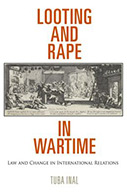Looting and Rape in Wartime: Law and Change in International Relations

Author: Tuba Inal
Publisher: Philadelphia, PA: University of Pennsylvania Press, 2013. 280p.
Reviewer: Nicola Henry | January 2015
The recent surge of international attention to the issue of wartime sexual violence is epitomised by the 2014 Global Summit to End Sexual Violence in Conflict, co-chaired by UK Foreign Secretary William Hague and film star and Special Envoy for the UN High Commissioner for Refugees, Angelina Jolie. This global spectacle stands in stark contrast to the historical silence surrounding this issue. Described as the “biggest global meeting on this issue ever convened”, the Global Summit has multiple aims, including creating a new International Protocol for the documentation and investigation of sexual violence in armed conflict; supporting countries to strengthen their domestic laws; instituting primary prevention measures to ensure military personnel do not engage in such acts; providing practical support to survivors; and, debunking the myth that wartime rape is an inevitable crime of war, and as such, producing a “seismic shift in attitudes.” Alongside populist and intergovernmental attention, scholars, activists and survivors have extensively written and campaigned about sexual violence in wartime, yet some scholars have questioned the desirability of fixating on wartime rape as the “worst of crimes,” arguing that such rhetoric can be used to advance political interests and ideologies, and present women as perpetually powerless, vulnerable and in need of protection by a heroic band of “international saviours.”
Although published before the 2014 Global Summit, Tuba Inal’s book, Looting and Rape in Wartime: Law and Change in International Relations, comes at a perfect time when the current global momentum on rape in wartime has reached its height and when international feminist scholars are divided on the desirability of such attention. Inal’s investigation into the prohibition regime underpinning both looting and rape reminds us that although wartime rape is currently receiving unprecedented attention, if one traces the status of rape throughout the history of warfare, it is indisputable that it was widely accepted as an inevitable yet unspeakable by-product of war.
The broader and more abstract question of Inal’s fascinating book is why and how change happens. Using this simple but effective question, Inal seeks to uncover why international laws eventually regulated pillage of property, but failed to prohibit the rape of women, especially when women were considered the property of men, and states had invested interests in protecting property rights. She asks: “why did states choose to codify pillage as a violation of international law yet neglect rape for almost a century after that codification?” (p5). She refers to “prohibition regimes” as “sets of implicit or explicit principles, norms, rules, and decision-making procedures around which actors’ expectations converge in a given area of international relations” (p2). She is interested to explain how, when, and why a certain behaviour becomes transformed into a deviant act that affronts the morals and values of “civilised” nations.
In order to assess the unique and complex turning points for both crimes throughout international legal history, Inal relies on three core components: obligation (whether states are bound by a rule or commitment and the strength of this bind); precision (the degree to which rules are defined); and delegation (the authority of third parties to implement, interpret and apply rules). This framework enables her to microscopically assess the varying levels of prohibition at particular points of time. She adds to this complexity by investigating how and when international political orders are “created, maintained and abandoned” (p7). She draws on international relations theory, and weaves together different approaches to analyse both the self-interests of states (e.g. image protection) and the activity of non-governmental and other actors as precursors to political change.
Inal gives compelling explanations as to the emergence of prohibition regimes around both pillage and rape, and the striking discrepancy between the prohibition of one but not the other. She adds another layer of complexity by introducing the notion of normative shocks, which she defines as: “tragic situations or events that shock the public conscience into focusing on particular activities or institutions and change the core norms, taking people out of the existing normative context and into another one” (p4). She argues that three conditions are necessary for the emergence of a global prohibition regime: first, the prohibition must reflect the self-interests of states; second, these cost-benefit calculations must be underpinned by ideational factors that support a new normative framework that seeks to prohibit certain acts or behaviours ; and third, these ideas must be actively promoted by state and non-state actors who can draw on the normative shocks as a way to further consolidate the prohibition and compel states to comply.
Overall, Inal does a superb job of examining the nuances and complexities of international prohibition regimes around wartime sexual violence. She examines in great detail the negotiations over the 1907 Hague Conventions; the 1949 Geneva Conventions (and the 1977 additional protocols); and the 1998 Rome Statute for the creation of the International Criminal Court (ICC). I thoroughly enjoyed reading about the behind-the-scenes negotiations and deliberations that took place over the inclusion and exclusion of crimes, and the eventual choice of language. This methodology can be usefully extracted to a whole range of other contexts. For example, it helped me to think about other momentous changes, such as the introduction of anti-discrimination legislation on the basis of race, religion, sex, disability or age, or the emergence of reforms to rape laws in domestic criminal justice realms, among many other issues. Although her focus is on the emergence of prohibition regimes and not on whether or not states are compliant with international law, in the conclusion of the book there was a brief discussion on compliance and enforcement, which serves as an important reminder about the gap between “law in the books” and “law in action”; a gap that is worth thinking about for anyone reflecting on the past and present status of wartime sexual violence, and whether substantive change in practice has indeed occurred. I would have liked more reflection on the issues that have divided feminists in this space — for example, the various discourses around genocidal rape; the turn to law and legal redress as the normative solution to injustice; and the prioritisation of sexual violence on the international agenda. The book does touch upon these issues, but they are not explored in any depth.
This is an enthralling book that tells a fascinating story about international law, politics and gender, and the gradual recognition of rape as a grave crime that has finally shocked the conscience of the international community (or at least is slowly getting there).
Nicola Henry – Senior Lecturer in Legal Studies, La Trobe University, Melbourne, Australia


